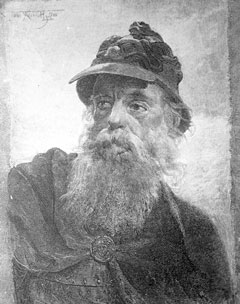Jean-Vincent d'Abbadie de Saint-Castin facts for kids
Quick facts for kids
Saint-Castin
|
|
|---|---|

Will H Lowe: Baron De St Castin, fantasy portrait 1881
|
|
| Born | 1652 Escout, Béarn, France |
| Died | 1707 (aged 54–55) |
| Allegiance | France, Abenaki |
| Battles/wars |
King Philip's War (1675-1676) |
| Other work | representative |
| Signature | |
Jean-Vincent d'Abbadie de Saint-Castin (1652–1707) was a French soldier and an Abenaki chief. He lived in a region called Acadia, which is now part of Canada and the northeastern United States. Saint-Castin had two important sons, Bernard-Anselme and Joseph, who also became military leaders. The town of Castine, Maine is named after him. He passed away in Pau, France in 1707.
Contents
Early Life and Adventures
Jean-Vincent d'Abbadie de Saint-Castin was born in 1652 in Escout, Béarn, France. He was the youngest of three sons. Sadly, he lost his mother when he was a baby and his father before he became a teenager.
When he was just thirteen, Saint-Castin left France for Canada. He joined the army as an ensign, which was a junior officer rank. This was a common path for the youngest sons of noble families.
Joining the Abenaki People
Around 1666, Saint-Castin likely took part in a French military campaign against the Iroquois people. By 1670, he was involved in France taking back control of Acadia. He spent time in the Penobscot River area, where he learned a lot about the local Penobscot people. He eventually became part of their tribe.
In 1674, during a conflict, Saint-Castin was captured by the Dutch and taken to Boston. After he returned, the French Governor Frontenac gave him an important job: to make the Abenaki people allies with the French. Saint-Castin helped recapture Fort Pentagouet, the former capital of Acadia, in 1675 during King Philip's War. He took his new role very seriously. Even though he inherited a noble title (Baron de Saint-Castin) that year, he chose to focus on living as an Abenaki.
Battles and Conflicts
During King William's War, Saint-Castin led a group of over 400 soldiers. In May 1690, they attacked and destroyed the English settlement at Falmouth, Maine. This happened after an English ranger named Benjamin Church had defended the settlers there the previous autumn.
Family Life
Saint-Castin married at least one daughter of Madockawando, a Penobscot chief. Some historical accounts suggest he might have married two of the chief's daughters. He had many children with her.
Saint-Castin's Children
Saint-Castin had several daughters. Some of them married Frenchmen. He also had two sons who became very well-known: Bernard-Anselm (born around 1689) and Joseph (born around 1690). Another son, Jean-Pierre, died young in Quebec. Two of his daughters, Thérèse and Anastasie, were married on the same day in 1707.
Later Years and Return to France
By 1700, Saint-Castin was known to be friendly with some English settlers. He even spoke English and was interested in trading with them. He once told an English sailor that he hoped to be under English rule instead of French rule. He also suggested that the border between New France and the English colonies should be the St. Croix River.
In 1701, Saint-Castin went back to France. He had to answer questions about his loyalty because of what he had said to the English. He also needed to deal with legal matters to get his family's inheritance. He died in France in 1707.
The Buried Treasure
Before he left for France, Saint-Castin seems to have buried a large amount of silver coins near the Bagaduce River. He didn't tell his family or friends about it. This hidden treasure was found almost 150 years later by people living in the area.
Descendants and Legacy
Saint-Castin's son, Bernard-Anselme, sailed to France in 1714 with his wife and daughter. He wanted to prove he was a legitimate heir and claim his father's title and inheritance. Bernard-Anselme died in 1720, and his family stayed in France.
The Saint-Castin name continued in the Penobscot region through his son Joseph. Joseph was still in contact with the English governor of Massachusetts as late as 1750.
On September 4, 1707, Saint-Castin's daughter Anastasie married a descendant of Acadian governors. On the same day, another daughter, Marie-Thérèse, married into another important Acadian family.
Legacy
- The famous American poet Henry Wadsworth Longfellow wrote a poem called "The Baron of St. Castine."
- The town of Castine, Maine is named after him.
- A street at Dalhousie University is named Castine Way.
- He is featured in a historical fiction book called The Chase of Saint-Castin and Other Stories of the French in the New World by Mary Hartwell Catherwood.

